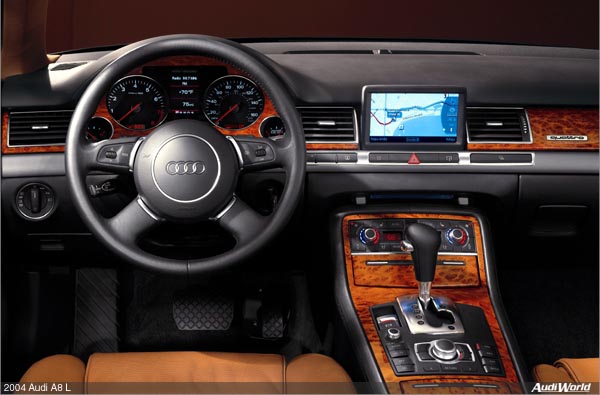Audi Multi Media Interface

Audi has always focused on developing technology that works for consumers, not against them. The latest Audi innovation is an intuitive system for operating onboard electronics. The Audi Multi Media Interface (MMI) joins the list of Audi advancements, including the legendary quattro® all-wheel drive system for traction and performance, the extensive use of aluminum for automobile strength, and the efficiency of the gearless multitronic™ Continuously Variable Transmission (CVT). The Multi Media Interface is another example of Audi’s commitment to keeping the focus on driving. Instinctive and easy to operate, this state-of-the-art technology is offered on the brand’s luxury flagship sedan, the all-new 2004 Audi A8 L. MMI is a user-friendly interface for the operation of onboard electronic systems — everything from the radio/CD player and suspension dynamics and ride height to the Audi Navigation System. MMI allows control without diverting attention from driving. Onboard electronics often have individual operating procedures, many also with their own displays. The “mental gymnastics” required to control all these devices creates the potential for confusion, or even worse, driver distraction. Audi MMI helps drivers keep focused on the road by creating a common onboard electronics operating principle in a single control unit. MMI also replaces the multiple and often dissimilar displays of various onboard electronics with a single monitor providing pictograph guidance and visual confirmation of inputs. The MMI terminal is ergonomically located in the center console, behind the shifter and just forward of the armrest, for comfortable reach. Operating controls consist of a rotating On/Off and Volume knob (A), a rotate- and push-to-select center knob (B), four “soft” keys (C), four “hard” keys (D) and a “Return” and directional keys (E). The operating principle of MMI is logical and quick to learn: Rotate the On/Off knob and then push the “hard” key of the electronics category to be adjusted; depress a “soft” key that corresponds to the category item as identified on the monitor; then rotate the center knob to the preferred adjustment as indicated on the monitor, and push down the center knob to select the desired action. The “Return” key scrolls back through the command screens one at a time, convenient for readjustments and corrections. To adjust multiple electronics, simply repeat the process starting with the appropriate “hard” key. To simplify MMI operation, commonly used items are up high in the electronic menu for quick access. Less commonly required and infrequently altered items are located in sub-menus that can be scrolled through using the left- and right-arrow keys. The upper left “hard” key accesses Entertainment functions for the radio and CD. The lower left “hard” key opens Communication controls for telematics and hands-free mobile telephone systems. The upper right “hard” key produces Information controls for navigation. The lower right “hard” key opens Vehicle controls for set-up of ride and drive dynamics, as well as for establishing driver-preferred settings. To operate MMI, Audi drivers need to remember only four basic steps: Audi recognizes the inherent safety value of keeping attention focused on driving, with both eyes on the road and both hands on the steering wheel. Remote thumb-wheel controls on the steering wheel allow access to the main MMI functions without causing a driver to take a hand off the steering wheel. Visual Confirmation Audi MMI incorporates two monitors in the driver’s sight line for quick visual reference while selecting and confirming functions. The main MMI display is a seven-inch, flat-screen monitor (D) located in the dashboard, above the center console, and angled slightly toward the driver position. Turning on MMI causes the central display to silently slide open and rotate up into position. When pushed closed, trim matching the interior design is revealed. The large screen provides a real-time, color-coded display of inputs made at the MMI terminal. Selecting the top-left “soft” key, for example, highlights the top-left portion of the MMI screen, where corresponding choices within the function are listed. A smaller three-inch MMI monitor (E) is positioned in the center of the instrument gauge cluster, positioning it directly in front the driver to help keep their eyes on the road. This secondary MMI display uses menu designs similar to the dashboard monitor, avoiding confusion and recognition delay when drivers switch from looking at one screen to the other. The graphics-capable instrument panel display provides relevant MMI data as well as certain vehicle reports, such as the results of automatic vehicle systems checks, navigation information and cruise control functions and operational status. Frequently used infotainment functions, such as radio station selection and volume control, are also displayed on the MMI instrument cluster monitor. Familiar Safety and Convenience While MMI is clearly a technological advancement in the control of onboard electronics, Audi engineers determined some functions require such immediate access that it is better to keep them separate from the MMI system. Heating, Ventilation and Air Conditioning (HVAC) system controls remain as independent knobs and switches located in the center stack of the console. The benefit of familiarity with operation and even location of the automatic climate controls is readily apparent when an immediate change is required, such as when it’s suddenly necessary to clear the windshield of fog caused by a sudden storm. |
